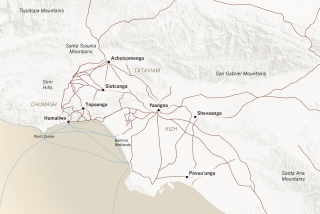Indian Tradition Standing Tall
- Share via
The carving of totem poles is considered a nearly lost art among North American Indians, but a brand new one, painted red, black and green and topped with a carving of the mythical thunderbird, now stands outside the Southwest Museum in Highland Park.
The recent installation culminated a three-month cooperative effort between the museum and Canadian officials, during which the public was invited to watch the totem pole as it was created by Canadian Indian carvers in downtown Los Angeles.
The museum, Director Patrick T. Houlihan said, wanted “to show something of the process rather than simply the product and to show it is a continuing tradition that lives today.”
Totem poles were traditionally carved by Indians living along the Northwest Pacific Coast, particularly of the Haida and Kwakiutl tribes along the Canadian coast of British Columbia. The Indians did not worship these works but created them as family memorials equivalent to family crests in Western culture.
Last November, the Canadian government shipped a 4,000-pound Canadian cedar log to the museum, which installed it in a satellite branch at the Arco Plaza in downtown Los Angeles. Then Richard Hunt, a Kwakiutl Indian and principal carver, came from British Columbia and began to carve--in full public view. He was later assisted by another Indian carver, Tim Paul.
The resulting 20-foot-high combination of human and animal forms shows a bear beneath the thunderbird at the top and between its wings. Below that is a killer whale, grasping a seal, with a man upside down on the whale’s back. The symbolism comes from Hunt family lore.
The finished product was then installed outside the museum at 234 Museum Drive.
More to Read
The biggest entertainment stories
Get our big stories about Hollywood, film, television, music, arts, culture and more right in your inbox as soon as they publish.
You may occasionally receive promotional content from the Los Angeles Times.










